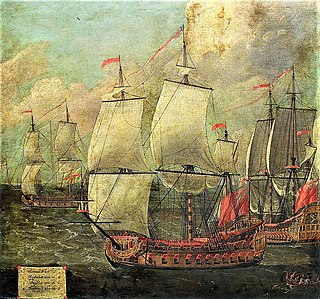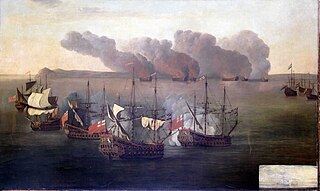Nonsuch was a 32-gun fourth-rate of the English Navy, built by Peter Pett I at Deptford Dockyard and launched in 1646. She was in the Parliamentary force during the English Civil War, then the Commonwealth Navy and was incorporated into the Royal Navy after the Restoration in 1660. During her time in the Commonwealth Navy she partook in the Battles of Krntish Knock, Portland and Gabbard. She was wreck at Gibraltar in 1664.

Elizabeth was a 38-gun fourth rate vessel of the Kingdom of England, Her initial commission was in the Parliamentary Naval Force during the English Civil War. During the Anglo-Dutch War she missed all the major Fleet actions. During the Second Anglo-Dutch War she participated in the St James Day Fight. She was burnt by the Dutch off Virginia in March 1667.
The Pelican was one of six 40-gun fourth-rate frigates, built for the Commonwealth of England under the 1650 Programme. After commissioning she partook in the First Anglo-Dutch War being present at the Battles of Kentish Knock, Portland, the Gabbard and Scheveningen. She was accidentally burnt at Portsmouth in early 1656.

HMS Centurion was one of six 40-gun fourth-rate frigates, built for the Commonwealth of England under the 1650 Programme, she would be transferred to the navy of the Kingdom of England upon the Restoration of the monarchy in May 1660. When commissioned she partook in the First Anglo-Dutch War. After the first war ended she was in the Mediterranean fighting the Algerines at the Battle of Santa Cruz. She fought the battles of Dover, Portland, the Gabbard, and Scheveningen. During the Second Anglo-Dutch War she partook in the battles of Lowestoft and Orfordness. Following the second war she spent her time either in North America or the Mediterranean. She was wrecked in a storm in December 1689.

Foresight was a 40-gun fourth-rate of the Commonwealth of England, after the Restoration of the monarchy in 1660 she was incorporated into the Navy of the Kingdom of England. During her time in the Commonwealth Navy she partook in the First Anglo-Dutch war being present in the battles of Dungeness, Kentish Knock, Portland, The Gabbard and Scheveningen. She was also present at the Battle of Santa Cruz and the bombardment of Porto Farina, In the Second Anglo-Dutch War she was involved in the Battle of Vagen and the St James Day Fight. During the Third Anglo-Dutch War she participated in the battles of Schooneveld and Texel. For the remainder of her career she was in the West Indies, the Mediterranean and North American waters. She was wrecked south of Cuba in July 1698.
Laurel was a 48-gun fourth-rate of the navy of the Commonwealth of England. She participated in almost all major Fleet Actions of the First Anglo-Dutch War. She was an active participant in the battles of Kentish Knock, Dungeness, Portland, The Gabbard and Scheveningen. She went to the west Indies with Admiral William Penn. She was wrecked in May 1657.
The 1689 Programme of fifth rates were devised by Admiral the Earl of Torrington as the prototype demi-batterie ships of the Royal Navy. The concept was to have one tier of ordnance flush on the upper deck for use in all weathers on a freeboard of at least seven feet. The ordnance would be arranged with a minimum of ten gun ports on the upper deck. The lower deck would be provided with four ports for heavier guns that could only be used in calm weather. For added propulsion ten oar ports per side would be provided with a central loading port. Five new 32-gun vessels to these specifications were ordered from Naval Dockyards in June 1689.
The 1693 Programme of fifth rates were derived from the 1698 programme vessels as demi-batterie ships. The concept was to have one tier of ordnance flush on the upper deck for use in all weathers on a freeboard of at least seven feet. The ordnance would be arranged with a minimum of ten gun ports on the upper deck. The lower deck would be provided with four ports for heavier guns that could only be used in calm weather. For added propulsion ten oar ports per side would be provided with a central loading port. Four more 32-gun vessels to these specifications were ordered in early 1693 with three to be built by Contract and one in dockyard.
The 1694 Programme of 32-gun fifth rates were derived from the 1693 programme vessels as demi-batterie ships. The concept was to have one tier of ordnance flush on the upper deck for use in all weathers on a freeboard of at least seven feet. The ordnance would be arranged with a minimum of eleven gun ports on the upper deck. The lower deck would be provided with four to eight gun ports for heavier guns that could only be used in calm weather. For added propulsion ten oar ports per side would be provided with a central loading port. Nineteen more 32-gun vessels to these specifications were ordered in from 1694 to 1698 with Thirteen to be built by Contract and nine in dockyard.
The 1650 Programme of six 510 ton Fourth Rate vessels was initiated by the Council of State on 16 November 1649. On 2 January 1650 the Admiralty Committee confirmed that six 'frigrates' had been ordered at a cost of 6.10.0d per ton. The ships would be built under contract with the exception of one ship built in Dockyard. The ships were all named by 16 August 1650 and launched by the end of the year. Each ship was to carry initially 34 guns and 150 men. This would increase over time
Crane was a small galleon in the service of the English Navy Royal. She spent her early career in expeditions as far as Cadiz and the Azores. She later was assigned to the Channel Guard during two more attempts by Philip II of Spain to invade England. She maintained this assignment until she went to the Irish Station then back to the English Channel. She was finally sold in 1629.
Quittance was a small galleon in the service of the English Navy Royal. She spent her early career in expeditions as far as Cadiz. She was later assigned to the Channel Guard during two more attempts by Philip II of Spain to invade England. she maintained this assignment until she went to Monson's squadron then back to the English Channel. She was condemned in 1618.
Answer was a small galleon in the service of the English Royal Navy. She spent her early career in expeditions as far as Cadiz and the Azores. She was later assigned to the Channel Guard during two more attempts by Philip II of Spain to invade England. She maintained this assignment until she went to the Irish Station then back to the English Channel. She was finally sold in 1629.
Advantage was a small galleon in the service of the English Navy Royal. She spent her career in the Channel Guard during two more attempts by Philip II of Spain to invade England. She maintained this assignment until she went to the English Channel. She was accidentally burnt in Scotland in 1613.
Adventure was a 26-gun galley in the service of the English Navy Royal. She spent her early career in expeditions as far as West Indies, Cadiz and the Azores. She later was assigned to the Channel Guard during two more attempts by Philip II of Spain to invade England. She would spend the rest of her time in Home Waters, mainly the English Channel and North Sea. She was broken in 1645.
Mary Rose was a 26-gun ship in the service of the English Navy Royal. After commissioning she mainly served in Home waters. With the outbreak of the English Civil War in 1642 she was in the service of the Parliamentary Forces. She served until wrecked in a storm in 1650.
The 1637 Group of two 300 ton 'pinnances' to carry fourteen pieces of ordnance and sixteen banks of oars were ordered on 12 December 1636. These vessels would carry thirty pieces of ordnance with ten pairs of gun ports on the lower deck with two pair forward and four pairs aft on the upper deck. The waist would be unprotected until two more pairs of gun ports were added later. Their measurements would compare favourably to the 'frigate' type vessels built a decade later. Their beam to length ratio of 3.46 to 1 would make a more true frigate than the Constant Warwick.
Expedition was a 30-gun pinnance in the service of the English Navy Royal. She spent her career in Home Waters. During the English Civil War she was employed in the Parliamentary Naval Force. In 1551 she was assigned to the Commonwealth Navy. She was in the Battle of Gabbard and Scheveningen in 1653. Upon the Restoration in 1660 she participated in the battles of Lowestoffe, Four Days' Fight and Orfordness in 1666. She was converted to a fireship then sold in 1667.
Amity was a 36-gun fourth rate vessel of the Commonwealth of England. She was purchased by Parliament on 18 January 1650 and renamed. She was commissioned into the Parliamentary Naval Force as Amity. During the First Anglo-Dutch War she partook in the Battle of Portland and the Battle of The Gabbard. She was incorporated into the English Navy after the Restoration in May 1660. During the Second Anglo-Dutch War she participated in the Battle of Lowestoft, the Four Days' Battle and the St James Day Fight. She was sold on 27 November 1667.
Convertine was a 36-gun fourth rate vessel captured from the Portuguese by the Commonwealth of England. She was commissioned into the Parliamentary Naval Force as Convertine. During the First Anglo-Dutch War she partook in the Battle of Dungeness, Battle of Portland and the Battle of the Gabbard. During the Second Anglo-Dutch War she participated in the Battle of Lowestoft and the Four Days' Battle. She was captured during the Four Days' Battle.

